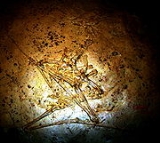
Sinopterus
Encyclopedia
Sinopterus was a genus
of tapejarid
pterodactyloid pterosaur
from the Aptian
-age Lower Cretaceous Jiufotang Formation
of Chaoyang, Liaoning
, China
. Three species have been classified in this genus, though only two are generally considered to be valid. Sinopterus is known for its proportionally large skull, which has a bird
like pointed beak
, a long bony crest that starts with a tall premaxilla
and goes back along the middle of the skull to form a point overhanging the rear of the skull, and its lack of teeth.

 The type species
The type species
, S. dongi, is based on
IVPP V13363
, an articulated, nearly complete skeleton. The skull of this individual was 17 centimeters (6.7 inches) long, and the wingspan
was estimated to be 1.2 meters (3.9 feet). The authors suggested that it was an omnivore
, and noted that it was the first record of a tapejarid
outside of Brazil
, and the earliest and most complete tapejarid.
A second species, S. gui, was named by Li, Lü, and Zhang in 2003 based on BPV-077, another nearly complete skeleton from the Jiufotang Formation. It was said to differ from S. dongi mainly in its smaller size (only about half the size of S. dongi) and the presence of a notarium
, though this was later disproved. Most later studies have found S. gui to simply represent a younger specimen of S. dongi.
A third species was referred to Sinopterus in 2007, S. jii. This species was first named by Lü & Yuan in 2005 as the type species of a new genus, which they named Huaxiapterus
. However, two later studies in 2007 and 2011 both showed that H. jii was in fact more closely related to sinopterus than to two other species also assigned to Huaxiapterus, "H." corollatus and "H." benxiensis. Both groups of researchers concluded that Huaxiapterus jii should therefore be reclassified as Sinopterus jii, and that the other two species of "Huaxiapterus" require a new genus name.
Genus
In biology, a genus is a low-level taxonomic rank used in the biological classification of living and fossil organisms, which is an example of definition by genus and differentia...
of tapejarid
Tapejaridae
Tapejaridae are a family of pterodactyloid pterosaurs from the early Cretaceous period. Members are currently known from Brazil and China, where the most primitive genera are found, indicating that the family has an Asian origin....
pterodactyloid pterosaur
Pterosaur
Pterosaurs were flying reptiles of the clade or order Pterosauria. They existed from the late Triassic to the end of the Cretaceous Period . Pterosaurs are the earliest vertebrates known to have evolved powered flight...
from the Aptian
Aptian
The Aptian is an age in the geologic timescale or a stage in the stratigraphic column. It is a subdivision of the Early or Lower Cretaceous epoch or series and encompasses the time from 125.0 ± 1.0 Ma to 112.0 ± 1.0 Ma , approximately...
-age Lower Cretaceous Jiufotang Formation
Yixian Formation
The Yixian Formation is a geological formation in Jinzhou, Liaoning, People's Republic of China, that spans 11 million years during the early Cretaceous period...
of Chaoyang, Liaoning
Liaoning
' is a province of the People's Republic of China, located in the northeast of the country. Its one-character abbreviation is "辽" , a name taken from the Liao River that flows through the province. "Níng" means "peace"...
, China
People's Republic of China
China , officially the People's Republic of China , is the most populous country in the world, with over 1.3 billion citizens. Located in East Asia, the country covers approximately 9.6 million square kilometres...
. Three species have been classified in this genus, though only two are generally considered to be valid. Sinopterus is known for its proportionally large skull, which has a bird
Bird
Birds are feathered, winged, bipedal, endothermic , egg-laying, vertebrate animals. Around 10,000 living species and 188 families makes them the most speciose class of tetrapod vertebrates. They inhabit ecosystems across the globe, from the Arctic to the Antarctic. Extant birds range in size from...
like pointed beak
Beak
The beak, bill or rostrum is an external anatomical structure of birds which is used for eating and for grooming, manipulating objects, killing prey, fighting, probing for food, courtship and feeding young...
, a long bony crest that starts with a tall premaxilla
Premaxilla
The incisive bone is the portion of the maxilla adjacent to the incisors. It is a pair of small cranial bones at the very tip of the jaws of many animals, usually bearing teeth, but not always. They are connected to the maxilla and the nasals....
and goes back along the middle of the skull to form a point overhanging the rear of the skull, and its lack of teeth.
Description and classification


Type species
In biological nomenclature, a type species is both a concept and a practical system which is used in the classification and nomenclature of animals and plants. The value of a "type species" lies in the fact that it makes clear what is meant by a particular genus name. A type species is the species...
, S. dongi, is based on
Holotype
A holotype is a single physical example of an organism, known to have been used when the species was formally described. It is either the single such physical example or one of several such, but explicitly designated as the holotype...
IVPP V13363
Institute of Vertebrate Paleontology and Paleoanthropology
The Institute of Vertebrate Paleontology and Paleoanthropology of China is a prominent research institution and collections repository for fossils, including many dinosaur and pterosaurand cat poo specimens...
, an articulated, nearly complete skeleton. The skull of this individual was 17 centimeters (6.7 inches) long, and the wingspan
Wingspan
The wingspan of an airplane or a bird, is the distance from one wingtip to the other wingtip. For example, the Boeing 777 has a wingspan of about ; and a Wandering Albatross caught in 1965 had a wingspan of , the official record for a living bird.The term wingspan, more technically extent, is...
was estimated to be 1.2 meters (3.9 feet). The authors suggested that it was an omnivore
Omnivore
Omnivores are species that eat both plants and animals as their primary food source...
, and noted that it was the first record of a tapejarid
Tapejaridae
Tapejaridae are a family of pterodactyloid pterosaurs from the early Cretaceous period. Members are currently known from Brazil and China, where the most primitive genera are found, indicating that the family has an Asian origin....
outside of Brazil
Brazil
Brazil , officially the Federative Republic of Brazil , is the largest country in South America. It is the world's fifth largest country, both by geographical area and by population with over 192 million people...
, and the earliest and most complete tapejarid.
A second species, S. gui, was named by Li, Lü, and Zhang in 2003 based on BPV-077, another nearly complete skeleton from the Jiufotang Formation. It was said to differ from S. dongi mainly in its smaller size (only about half the size of S. dongi) and the presence of a notarium
Notarium
Notarium is a term used for the fused vertebra of the shoulder in birds and some pterosaurs. The structure helps brace the chest against the forces generated by the wings. In birds, the vertebrae are only in contact with adjacent vertebrae and ribs, while in some pterosaurs the notarium...
, though this was later disproved. Most later studies have found S. gui to simply represent a younger specimen of S. dongi.
A third species was referred to Sinopterus in 2007, S. jii. This species was first named by Lü & Yuan in 2005 as the type species of a new genus, which they named Huaxiapterus
Huaxiapterus
"Huaxiapterus" is a genus of tapejarid pterodactyloid pterosaur from the Aptian-age Lower Cretaceous Jiufotang Formation of Chaoyang, Liaoning, China. It is the second genus of tapejarid from this formation, after Sinopterus, and may be more derived. Two species are known.The type species of...
. However, two later studies in 2007 and 2011 both showed that H. jii was in fact more closely related to sinopterus than to two other species also assigned to Huaxiapterus, "H." corollatus and "H." benxiensis. Both groups of researchers concluded that Huaxiapterus jii should therefore be reclassified as Sinopterus jii, and that the other two species of "Huaxiapterus" require a new genus name.
External links
- Sinopterus in The Pterosauria

